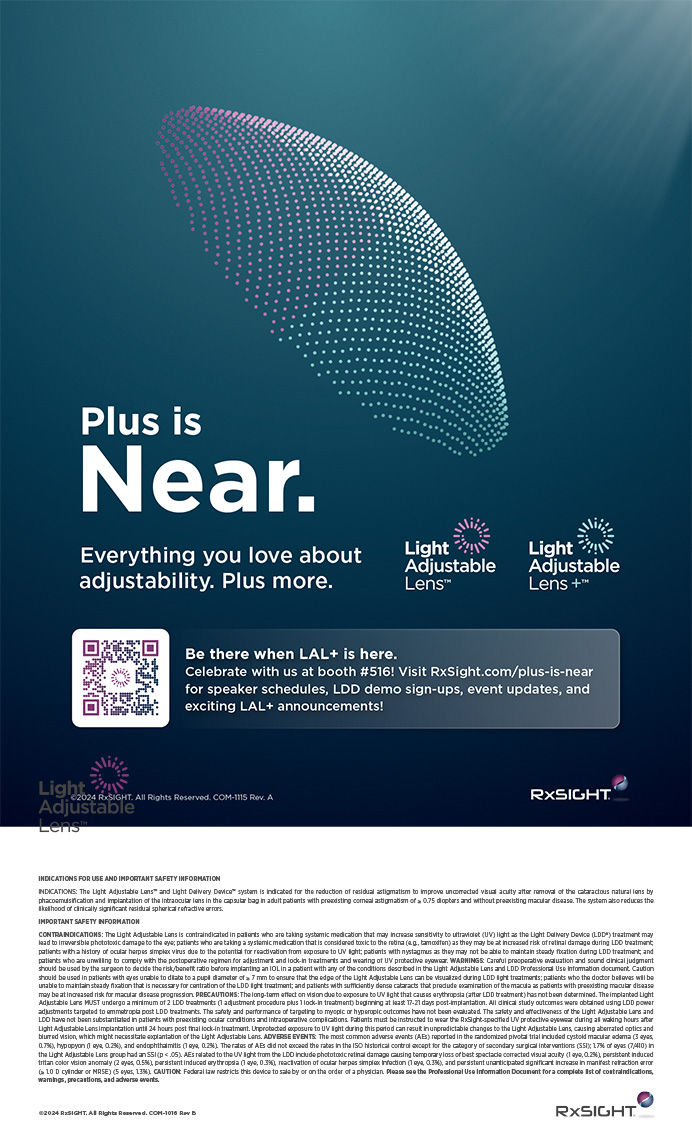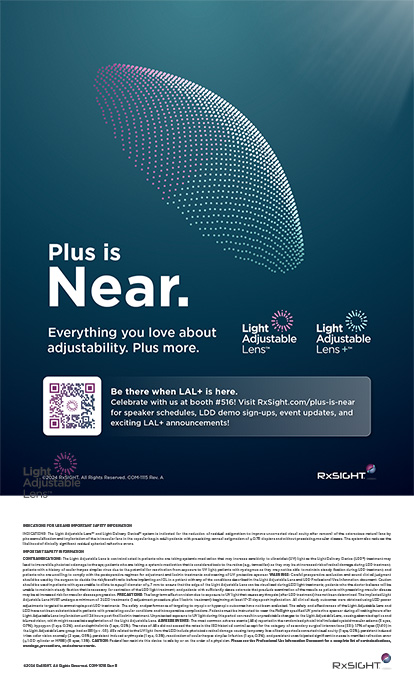Case Presentation
A 60-year-old white female with mixed astigmatism presented to my office. Her original evaluation was conducted in May 2001, and her refractive error was +3.75 -4.25 X 025 OD, and +4.75 -4.50 X 160 OS (Table 1). Because of the patient's age, I paid special attention to the cornea and lens during slit lamp examination; both were clear and free of any visible pathology. The patient had worn hard contact lenses years ago, but now relied solely upon spectacles. Although her uncorrected distance acuity was only 20/80, she went without her glasses for many activities. I told the patient that laser vision correction could make her uncorrected vision better, but not perfect. Based upon her response, (“Just fix half of it, and I'll be happy”) we elected to proceed with LASIK OU.
In June 2001, the patient presented to our laser center for bilateral sequential LASIK. Her preoperative medications were limited to one drop each of proparacaine, tropicamide, phenylephrine 2%, and Ocuflox (Allergan, Inc., Irvine, CA). After her pupils dilated to greater than 7 mm, I positioned her under the laser (LADARVision; Alcon Laboratories, Fort Worth, TX) and administered one drop each of proparacaine and tetracaine to both eyes. I draped the patient's lids, applied one drop of Celluvisc (Allergan, Inc.), and gently inserted a wire lid speculum. Next, I applied an inked 3-mm optical zone marker to the peripheral cornea to aid in flap repositioning. The corneal epithelium surrounding the marker detached from the underlying cornea leaving a 4-mm sheet of loose epithelium. It appeared to me that the patient had defective epithelial basement membrane adhesion, and that LASIK would be a poor procedure choice. I felt it was likely that a microkeratome pass would lead to a total slough of the epithelium, a high risk of epithelial ingrowth, and delayed epithelialization.
How Would You Proceed?1. Would you proceed to do LASIK or convert to PRK?
2. Did you obtain the patient's informed consent for PRK prior to surgery?
3. Would you alter your planned ablation dosage if converting to PRK?
4. Would you treat both eyes on the same day?
Surgical Course
I chose to proceed with PRK OD. This approach combines the therapeutic effect of PTK with the refractive correction of LASIK, but allows each eye to be treated with a single procedure. The option to change the surgical procedure from LASIK to PRK required that the patient provide her informed consent for PRK prior to surgery. An informed consent obtained midsurgery is both unfair to the patient and invalid in court. Although we could have rescheduled the case for a later date, the patient elected to proceed and have her first eye treated.
In order to allow us the flexibility to convert from LASIK to PRK, we discuss the following issues with our patient preoperatively: (1) What is PRK and why would we choose it over LASIK? (2) What are the risks of PRK? and (3) What is the usual recovery from PRK?
We did not alter the original surgical plan for LASIK, treating for the patient's full manifest refractive error of +3.50 -4.25 X 025 OD. She expressed her desire to delay treatment of her second eye until her first eye had recovered. Thus, within less than a minute from detecting her epithelial basement membrane pathology, we were able to begin PRK for her right eye confident in our decision, our patient's education and consent, and our surgical plan.
To begin the case, I wiped off the epithelium with a Weck cell sponge; minimal use of the Tooke knife was required. Next, I wiped Bowman's membrane with a damp Weck cell sponge, and locked the eye into tracking using the LADARVision system. The treatment required 58 seconds and an ablation depth of 57 µm. I applied a topical antibiotic, Celluvisc, and inserted a PureVision 8.6 BC lens (Bausch & Lomb, Rochester, NY). Epithelialization occurred over 7 days, and the patient underwent PRK in her left eye a few months later.
At 5 months post-PRK, the patient's right eye was plano with uncorrected distance acuity of 20/20 and uncorrected near of 20/25! Five weeks postoperatively, the nondominant left eye was -.75 -.75 X 170 with uncorrected distance vision of 20/25 and 20/30 near.
I learned two things from this case. First, our system of education and informed consent worked well, allowing us to quickly and confidently change from LASIK to PRK. Second, PRK for mixed astigmatism can yield extraordinary results (Figure 1). PRK avoids induced astigmatism from a LASIK hinge and with PRK, there is no loss of treatment area due to an inability to ?fit? the 9-mm ablation into the LASIK bed area. As a result of this case and others similar to it, I now encourage all my hyperopes and mixed astigmatism patients to choose PRK over LASIK.
In my current PRK technique, I use 20% alcohol for 25 seconds to loosen the epithelium and to facilitate atraumatic epithelial removal. For cases with an ablation depth greater than 50 µm, I apply 0.02% mitomycin C (MMC) for 2 minutes following ablation in order to diminish the risk of postoperative haze. In approximately 20 eyes treated with MMC, I have not seen any delay in epithelialization. This may be due to the use of a 6-mm corneal shield, which limits the MMC to the central cornea and avoids contact with the limbal epithelium. We are presently following 20 LASEK cases and 20 MMC PRK cases to try to determine the comparative incidence of corneal haze.
In summary, PRK has re-emerged as a vital part of my refractive surgery practice—both as a primary choice and as a valuable “plan B” alternative to LASIK. The right education and consent process helped minimize the added complexity of offering two laser vision procedures.R. Bruce Grene, MD, is CEO of Grene Vision Group in Wichita, Kansas. He does not hold a financial interest in any of the materials mentioned herein. Dr. Grene may be reached at (316) 691-4444. The entire preoperative screening form and our informed consent are available by sending your name and address to grenelaser@fn.net


